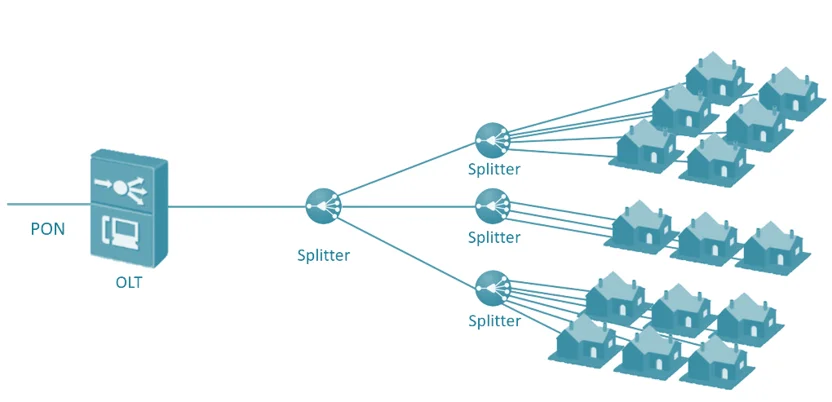Understanding Passive Optical Networks for your FTTH Deployment
Trusted by:


















In recent years, we’ve seen an increase in demand for effective fiber to the home (FTTH) networks, making it crucial to understand passive optical network (PON) technologies for seamless deployments. Network operators around the world are working hard to implement best in class fiber solutions for their customers; yet, it can be a daunting task to understand all the elements that go into a successful FTTH/FTTX deployment.
To help you out, we’ve put together a series of articles explaining the importance of each element that goes into a successful FTTH deployment. This first article is a quick reference guide on the various types of passive optical networks (PON).
PON Network Configuration

In every passive optical network (PON) visualization, the Optical Line Terminal (OLT) plays a key role, managing the connections to customer Optical Network Terminals (ONT), which are critical for efficient FTTH deployments. Occasionally, you will also hear people speak about an Optical Network Unit, which is another name for the ONT.
We often see a variety of configurations when reviewing PON network designs, such as multiple splitters between the OLT and ONT, enabling scalable and cost-effective FTTH deployments. By doing this, it allows for greater distance between the end points. The most commonly deployed solution we see in today’s market is GPONA splitter has 1 or 2 “in” ports and multiple “out” ports. Often the first splitter (seen from OLT) has 2 “in” ports for protection purposes. The downstream transmission (from OLT to ONT/ONU) and upstream (from ONT to OLT) are different.
One OLT port sends the same signal to each ONT/ONU connected; however, each ONT will send specific information back to the OLT. As each ONTs transmits different information, they each get an allocated timeslot to send their information. This is Time Division Multiplexing, TDM for short.
The OLT determines the distance and time delay of each subscriber. Then, software provides a way to allocate timeslots to upstream data for each user. Because it is shared, the upstream rate is lower than the maximum capacity. The typical split of a single fiber is 1:32 or 1:64. That means each fiber can serve up to 32 or 64 subscribers. Split ratios up to 1:128 are possible in some systems.
Differences between different Passive Optical Networks
What is the difference between GPON, GEPON, APON, BPON and 10G-PON (XG-PON)?
What is GPON?
GPON, or Gigabit Passive Optical Network, is currently the most popular choice for FTTH deployment due to its efficient use of bandwidth and scalability. The ITU-T standard is G.984. It delivers 2.488 Gbits/s downstream and 1.244 Gbits/s upstream. GPON uses two different wavelengths on a single node fiber. For downstream traffic, the wavelength is 1490 nanometer (nm) and upstream traffic is 1310 nm. For TV distribution, a third wavelength exists. This wavelength is 1550 nm.
What are APON and BPON?
APON stands for ATM Passive Optical Network and is an older PON variant based on ATM, Asynchronous Transfer Mode. BPON (broadband PON) is a result of further improvements to the original APON standard. This version, as well as the gradual falling out of favor of ATM as a protocol, led to the full, final version of ITU-T G.983. Although the standard can accommodate higher rates, a typical APON/BPON provides 622 megabits per second (Mbit/s) (STM4/OC-12) of downstream bandwidth and 155 Mbit/s (STM1/OC-3) of upstream traffic.
What are EPON and GEPON?
Ethernet Passive Network (EPON) can also be referred to as Gigabit Ethernet Passive Network (GEPON). EPON/GEPON employs a single Layer 2 network that uses IP to carry data, voice and video. EPON delivers 1-Gbit/s or 2.5Gbit/s symmetrical bandwidth and is typically more cost effective than GPON.
What is 10G-PON / XG-PON?
The next generation of ultra-fast PON networks, 10G-PON (or XG-PON), offers significant advancements in speed and capacity, making it an ideal choice for future-proofing FTTH deployments. This advancement in technology is designed to co-exist with previously installed equipment. The asymmetric 10G-PON is specified as XG-PON1 and provides 10 Gbit/s downstream and 2.5 Gbit/s upstream.
More expensive burst-mode lasers on the ONTs would allow for symmetric standards 10G-PON, known as XG-PON2 and XGS-PON (ITU-TG.9807.1). With 10 Gbit/s upstream, it can deliver an upstream transmission speed we haven’t seen before.
The framing is “GPON like” but uses different wavelengths from GPON. Using a WDM to separate them, GPON subscribers can be upgraded to 10G-PON incrementally, while GPON users continue on the original OLT. The 10 Gigabit PON wavelengths (1577 nm down / 1270 nm up) differ from GPON and EPON (1490 nm down /1310 nm up), allowing it to coexist on the same fiber with either of the Gigabit PONs.
We often get questions about Passive Optical Networks (PON) and FTTH deployments. Here are answers to some of the most common queries to help you better understand the topic
What is the role of an OLT in a PON?
The Optical Line Terminal (OLT) serves as the main control hub in a Passive Optical Network. It manages data transmission between the service provider and the Optical Network Terminals (ONTs) installed at customer premises.
How does GPON differ from EPON?
GPON uses Time Division Multiplexing (TDM) to transmit data and offers higher downstream and upstream speeds. EPON, on the other hand, uses Ethernet protocols and is typically more cost-effective for Ethernet-based services.
What are the typical splitter ratios in a PON network?
The most common splitter ratios are 1:32 or 1:64, meaning a single fiber can serve 32 or 64 endpoints. Higher ratios like 1:128 are possible, but they depend on the network’s design and requirements.
Can GPON and XG-PON coexist on the same fiber?
Yes, GPON and XG-PON can coexist using Wavelength Division Multiplexing (WDM), allowing gradual upgrades without disrupting existing GPON services.
What is the maximum range of a PON network?
The maximum range of a PON network is typically 20 km between the OLT and ONT. However, advanced configurations may extend this range with additional equipment.
If you have questions about how to plan, build and operate a PON network, we’re happy to schedule some time to talk. Feel free to connect with us on LinkedIn or send an email.



